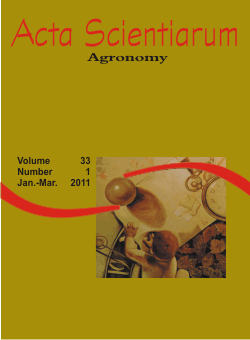<b>Drip fungigation in early blight control of tomato</b> - doi: 10.4025/actasciagron.v33i1.9515
Resumo
The aim was to verify if the fungigation via drip irrigation is an alternative to the conventional method of spraying on tomato for controlling early blight. Tomato plants (variety Santa Clara) were grown in pots inside a greenhouse. Fifty days after transplanting, the plants were inoculated with Alternaria solani and treated with four different fungicides: azoxystrobin (8 g 100 L-1), difeconazole (50 mL 100 L-1), metiram+piraclostrobin (200 g 100 L-1) and tebuconazole (100 mL 100 L-1) using two applications methods: conventional spraying and fungigation dripping. The control plants did not receive fungicide application. To assess the severity of the disease, we used a rating scale expressed as the area under the disease progress curve (AUDPC) and production factors, such as number, weight and average diameter of the fruit and its productivity. The experimental design was completely randomized in factorial scheme 4 x 2 + 1 with eight replicates. Each plot had one plant in one pot. A 27% reduction in disease severity was observed when compared with the control plants, with no significant difference noted regarding the application method. The number of fruits did not statistically differ between the treatments. The average weight and diameter of the fruits were superior in the plants that had fungicide application compared to the control plant, reflecting an increase in productivity. Fungigation through water dripping is an alternative to the conventional method of spraying cultured tomatoes.Downloads
DECLARAÇÃO DE ORIGINALIDADE E DIREITOS AUTORAIS
Declaro que o presente artigo é original, não tendo sido submetido à publicação em qualquer outro periódico nacional ou internacional, quer seja em parte ou em sua totalidade.
Os direitos autorais pertencem exclusivamente aos autores. Os direitos de licenciamento utilizados pelo periódico é a licença Creative Commons Attribution 4.0 (CC BY 4.0): são permitidos o compartilhamento (cópia e distribuição do material em qualqer meio ou formato) e adaptação (remix, transformação e criação de material a partir do conteúdo assim licenciado para quaisquer fins, inclusive comerciais.
Recomenda-se a leitura desse link para maiores informações sobre o tema: fornecimento de créditos e referências de forma correta, entre outros detalhes cruciais para uso adequado do material licenciado.




















































